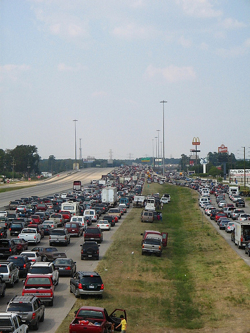 Do you have an emergency preparedness kit for your family?
Do you have an emergency preparedness kit for your family?
Don’t get caught short in the event of a natural disaster! Floods, hurricanes, earthquakes, fires, or severe winter storms can put your family at risk if you aren’t prepared. Trying to cope with having no power or water can be a stressful time, but there are steps that you can take to be prepared.
September is National Emergency Preparedness Month, and FEMA recommends having a kit ready in case of a disaster or evacuation. Going to the store and shopping during an evacuation will probably not be an option, so start putting together your family’s emergency preparedness kit, starting with the basics:
- Drinking water – Plan for one gallon per person per day. When electricity is out, you won’t have water except for what you’ve stored, so fill those containers today!
- Food for three days – Ready to eat and prepared foods will take the least effort, water, and fuel to cook. Energy bars and gorp get old really fast, so have plenty of canned or dehydrated foods, seasonings, and pans and utensils for serving. Don’t forget to pack a can opener!
- Stove and fuel – If you want hot food, you need a flame. A good short term solution is a simple backpacking stove, but for a family, a two burner camp stove is better. Get a gallon of gas for it and couple of lighters.
- First aid kit – A basic kit will see you through most minor medical needs, and bug spray and sunscreen are good additions. Any prescription medications you need should be packed with your supplies, and spare hearing aid batteries or eyeglasses can also be kept in the kit.
- Infant needs – Diapers, wipes, and extra clothes for your baby can be kept in a spare diaper bag for emergencies.
- Flashlight and batteries – An LED headlight is the best, as your hands are free. They don’t have to be fancy; a high/low switch and a headband are all you need. Each person should have one, plus a spare set of batteries for each. A hand-cranked rechargeable flashlight and some candles should be in your kit as well.
- Clothing – Collect a spare set of clothes, including a rain poncho, shoes, and hat, for each person.
- Toiletries – Pack TP, toothbrushes and toothpaste, soap, and a basin to wash in. You’ll be glad you did.
- Bedding – Have blankets or sleeping bags for each, plus a tarp for the family.
- Family records – Knowing what to grab beforehand will take a load off of your mind. Birth certificates, photos, ID, bank account information and insurance policy documents should all be included. If you back up all of your information onto a portable hard drive, you only need to remember to grab one thing.
- Radio – A shortwave or NOAA weather radio can keep you informed of the latest emergency warnings. A hand-cranked radio will let you listen in without being dependent on your battery supply.
- Kid’s activities – Keeping your little ones busy helps to ease the stress of evacuations and emergencies. Puzzles and coloring books won’t take up much space. Pack some paper and pens and a book or two for you – a first aid manual and survival guide is handy.
- Waterproof container for your kit – A five gallon bucket with a lid is a good choice, or any tight-sealing storage container with a handle will keep all your gear together.
This will start your home emergency kit, but having a smaller version in your car or at your workplace is also recommended. A go-bag with just the basics doesn’t take up much room and can be stashed in your trunk for roadside emergencies.
Start putting together your emergency preparedness kit today!
Related items:
Image: clicksense at Flickr under Creative Commons
PS: If you have pets, pack supplies for them as well!
It’s great to be prepared, and these tips are very helpful.
I’m glad I found your blog!
We also have lists for each family member that go beyond just our emergency supplies. What to grab if I only have 5 minutes, 10 minutes, 20 minutes, an hour. There are about 20 things on the list.
We keep all important documents like passports, birth certificates, etc. stored together so it only have to be one item on the list. You could also store copies of these things with your emergency kit. Also credit card information and phone numbers should go with the kit just in case you leave home in a rush and forget your wallet or purse entirely.
We also have one specific credit card that we have only for emergency use. We do NOT use it for anything else. And we store it in the emergency kit. People can be unscrupulus in disaster situations but we have that card available for whatever it is we might need.
You don’t need a disaster kit that takes a pickup truck to haul but you do need to have some things. Plan ahead and you won’t be sorry.
Oh, on the lists we made.. mine has things like, if I only have 5 minutes, I’m grabbing my wedding album and my laptop. If I have 10 minutes, I add a cherished quilt and our camera bag.
We also both keep (frequent) backups of our computers on flash drives with our important documents. That box, kept in our safe, is the first item on my husbands list.
Excellent points, Chris.
Lists are great, ’cause you might not be thinking too straight when it happens!
Very useful post. I’ll be rereading it as our car turns into our home on wheels for a few weeks.
Good common sense preparedness steps. I work on Penn. Ave in D.C., so you better believe I have an “out strategy.”